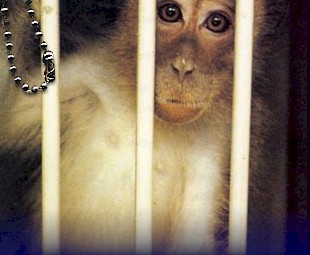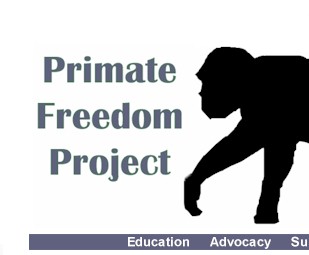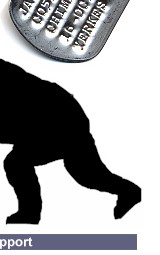The Primate
Freedom Project was sent a copy of the Summer 2001 Quarterly: The
Magazine for University of Wisconsin Medical School Alumni and Friends.
An article in the magazine, “New Brain Imaging Laboratory Draws
the Dalai Lama,” had caught the attention of an alert Primate
Freedom Project supporter. We found the following photograph on
16:
 The
caption reads: With UW Medical School’s Dr. Ned Kalin by
his side, the Dalai Lama learns how tracers are made for the Keck
Laboratory PET scanner. The
caption reads: With UW Medical School’s Dr. Ned Kalin by
his side, the Dalai Lama learns how tracers are made for the Keck
Laboratory PET scanner.
Ned Kalin is well known to those fighting to close the nation’s
primate laboratories for his experimental brain surgeries on the
emotion centers of monkeys. We wrote to the Dalai Lama and included
the following references and points for His Holiness’ consideration:
[Excerpt]
“Effects of amygdala lesions on sleep in rhesus monkeys.”
Benca RM, Obermeyer WH, Shelton SE, Droster J, Kalin NH. Department
of Psychiatry, University of Wisconsin - Madison, 6001 Research
Park Blvd., Madison, WI 53719-1176, USA. Brain Research 2000 Oct
6; 879 (1-2):130-8
“The amygdala is important in processing emotion and in the
acquisition and expression of fear and anxiety. It also appears
to be involved in the regulation of sleep and wakefulness. The purpose
of this study was to assess the effects of, fiber-sparing lesions
of the amygdala on sleep in rhesus monkeys (Macaca mulatta). We
recorded sleep from 18 age-matched male rhesus monkeys, 11 of which
had previously received ibotenic acid lesions of the amygdala and
seven of which were normal controls. Surface electrodes for sleep
recording were attached and the subjects were seated in a restraint
chair (to which they had been adapted) for the nocturnal sleep period.
Despite adaptation, control animals had sleep patterns characterized
by frequent arousals. Sleep was least disrupted in animals with
large bilateral lesions of the amygdala. They had more sleep and
a higher proportion of rapid-eye-movement (REM) sleep than did either
animals with smaller lesions or control animals. Based on these
results, it seems likely that, in the primate, the amygdala plays
a role in sleep regulation and may be important in mediating the
effects of emotions/stress on sleep. These findings may also be
relevant to understanding sleep disturbances associated with psychopathology.”
“Effects of acute and repeated restraint stress on corticotropin-releasing
hormone binding protein mRNA in rat amygdala and dorsal hippocampus.”
Lombardo KA, Herringa RJ, Balachandran JS, Hsu DT, Bakshi VP, Roseboom
PH, Kalin NH. Department of Psychology, University of Wisconsin,
Madison, WI 53706, USA. Neuroscience Letters 2001 Apr 20; 302 (2-3):81-4.
“Corticotropin-releasing hormone (CRH) mediates endocrine,
behavioral, and autonomic responses to stress. In addition to binding
to two receptor subtypes, CRH binds to a CRH-binding protein (CRH-BP).
While CRH-BP is hypothesized to play a role in regulating levels
of free CRH and modulating the stress response, the effects of stressors
on brain CRH-BP are relatively unexplored. The present study determined
effects of acute and repeated restraint on CRH-BP mRNA in basolateral
amygdala (BLA) and dorsal hippocampus (DH), brain regions involved
in fear and motivation. Using in situ hybridization, we found that
a single acute period of restraint significantly increased CRH-BP
mRNA in BLA by 20% but had no effect in DH. Repeated restraint had
no effect on basal levels of CRH-BP mRNA in BLA or DH. Importantly,
repeated restraint blocked the effects of acute restraint in the
BLA. These results demonstrate differential effects of acute and
repeated restraint on CRH-BP mRNA.”
Dr. Kalin has been systematically hurting animals since the very
early 1980’s. His behavior has not changed since the time he
coauthored, “Shuttlebox avoidance in rhesus monkeys: effects
on plasma cortisol and beta-endorphin,” a paper that appeared
in the journal Peptides in 1983. [Peptides 1983 Jan-Feb;4(1):19-24.]
I imagine you would have no need to know what a shuttlebox is, so
I will explain. A shuttlebox is a cage with two compartments with
a door between them. The floor of each side of the shuttlebox can
be electrified. First one side is electrified and an animal receives
a shock to his or her feet and jumps through the door. The floor
in that side is then electrified and the animal jumps back through
the door. The animal shuttles back and forth to avoid being shocked.
Often both sides are electrified simultaneously so that the animal
cannot avoid being shocked.
In the above paper, Dr. Kalin et al wrote: “Groups of monkeys
either extensively pretrained to avoid shocks in a shuttlebox or
with minimal prior experience were compared for plasma cortisol
and beta-endorphin levels immediately following: (1) an exposure
to the box with no shock, (2) the box providing repeated inescapable
shocks or (3) a re-exposure to the box, again with no shock presentation.
Mere exposure to the unfamiliar box elevated plasma cortisol just
as much as exposure + shock did when inexperienced monkeys were
tested. However, animals with a history of previously successful
shock avoidance showed smaller elevations when exposed to the box
alone, than they did when inescapable shock was received.”
Sincerely,
Rick Bogle, Founder
Primate Freedom Project
http://www.primatefreedom.com/
2251-A Refugio Rd.
Goleta, CA 93117
805 968 4531
We were pleased to receive the following reply:
Date: Thu,
06 Sep 2001 04:19:09 +0530
From: Office of His Holiness the Dalai
To: rbogle@sonic.net
Dear Rick Bogle,
Thank you for your e-mail letter of August 25 addressed to His Holiness
the Dalai Lama.
His Holiness appreciates your bringing to His attention about work
of Dr. Ned Kalin. His Holiness was not aware that Dr. Kalin was
involved in conducting tests on animals that were painful and extremely
cruel.
His Holiness has always been against such tests on animals. In fact,
when His Holiness offered to make a contribution to a research work
by Dr. Paul Ekman on the subject of CULTIVATING EMOTIONAL BALANCE.
His Holiness specifically pointed out that the research work should
not involve experiments on animals.
With best wishes,
Tenzin Geyche Tethong
It gives us hope that even world leaders are capable of compassion
and concern for the victims of rampant unbridled curiosity. The
triple efforts of the Primate Freedom Project are Education:
we must explain what is happening in the labs and what has been
learned about the minds and emotions of monkeys and apes. Advocacy:
having explained what is happening and who primates are, we must
assert that what is being done to them is unethical and immoral.
Support: we will offer every assistance and resource available
to us in support of others working to end the nightmare of experimentation
on monkeys and apes.
A wedge can be
forced between two seemingly immovable objects to force them apart.
The trick is to find a purchase for the thin leading edge.
Primate experimentation is the thin leading edge of the wedge of
public opinion that will move the animals out of the labs.
Home Page | Our Mission | News
What Are Primate Freedom
Tags | Order Tag
Primate Research
Centers | Resources
|







 The
caption reads: With UW Medical School’s Dr. Ned Kalin by
his side, the Dalai Lama learns how tracers are made for the Keck
Laboratory PET scanner.
The
caption reads: With UW Medical School’s Dr. Ned Kalin by
his side, the Dalai Lama learns how tracers are made for the Keck
Laboratory PET scanner.